
Sourdough Italian Demi-Baguettes: Variations on a Theme
David M. Snyder
May 3, 2015
Last month, I made some Sourdough Italian Rolls, using a formula I had developed and used previously to make bâtards. This week, I continued to play with this formula. I increased the proportion of durum flour in the dough, doubling the amount in the final dough, and I shaped the dough as demi-baguettes. (I wanted to make bâtards. My wife wanted more rolls to use for sandwiches. Demi-Baguettes was the compromise. We use that shape for sandwiches frequently.)
Total Dough |
|
|
Ingredient | Amount (gms) | Bakers' % |
AP flour | 334 | 60.7 |
Fine Durum flour | 200 | 36.4 |
WW flour | 11 | 2 |
Whole Rye flour | 5 | 1 |
Water | 400 | 72.7 |
Salt | 10 | 1.8 |
Sugar | 14 | 2.5 |
EVOO | 14 | 2.5 |
Total | 988 | 179.6 |
Liquid Levain |
|
|
Ingredient | Amount (gms) | Bakers' % |
Liquid starter | 40 | 40 |
Water | 100 | 100 |
AP flour | 70 | 70 |
WW flour | 20 | 20 |
Whole Rye flour | 10 | 10 |
Total | 240 | 240 |
Disperse the liquid starter in the water.
Add the flours and mix thoroughly.
Ferment at room temperature until expanded and bubbly (8-12 hours). If necessary, refrigerate overnight and let warm up for an hour before using.
Final Dough |
|
Ingredient | Amount (gms) |
AP flour | 300 |
Fine Durum flour | 200 |
Water | 350 |
Salt | 10 |
Sugar | 14 |
Active liquid levain | 100 |
EVOO | 14 |
Total | 988 |
Procedures
In a large bowl, disperse the levain in the water.
Add the flours and sugar to the liquid and mix to a shaggy mass.
Cover the bowl and let it rest for 20-60 minutes.
Add the salt and olive oil and mix thoroughly. (Note: I squish the dough with my hands until it comes back together, then do stretch and folds in the bowl until it forms a smooth ball and the oil appears completely incorporated.)
Transfer the dough to a 2 quart lightly oiled bowl, and cover the bowl tightly.
After 30 minutes, do stretch and folds in the bowl. Repeat 3 more times at 30 minute intervals.
Continue bulk fermentation for another 30-90 minutes, until the dough is puffy. If fermented in a glass bowl, you should see lots of little bubbles throughout the dough. Volume of the dough may have increased by 50% or so.
Refrigerate for 12-36 hours.
Divide the dough into 4 equal pieces and pre-shape as rounds or logs. Cover with a clean towel, baker's linen or plasti-crap and let rest for one hour.
Shape as Demi-Baguettes or Ficelles.
Roll the loaves on damp paper towels, then in a tray of sesame seeds. Alternatively, you can brush the loaves with water and sprinkle with sesame seeds.
Proof for about 45 minutes, seam-side down, on parchment paper pleated to separate the loaves and supported at both long sides by rolled-up dish towels. Cover with a damp towel, baker's linen or plasti-crap.
One hour before baking, pre-heat the oven to 480ºF with a baking stone and steaming apparatus in place.
When ready to bake, uncover the loaves. Pull the parchment from both long sides to flatten out the pleats and separate the loaves.
Transfer the loaves, on the parchment, to a peel. Score them as baguettes. Transfer them to the baking stone.
Steam the oven, and turn the temperature down to 460ºF.
After 10-12 minutes, remove the steaming apparatus. (Note: If you have a convection oven, switch to convection bake and turn the oven down to 435ºF for the remainder of the bake.) Continue baking for another 6-8 minutes or until the loaves are nicely browned and the internal temperature is at least 205ºF.
Transfer the loaves to a cooling rack. Cool completely before eating.
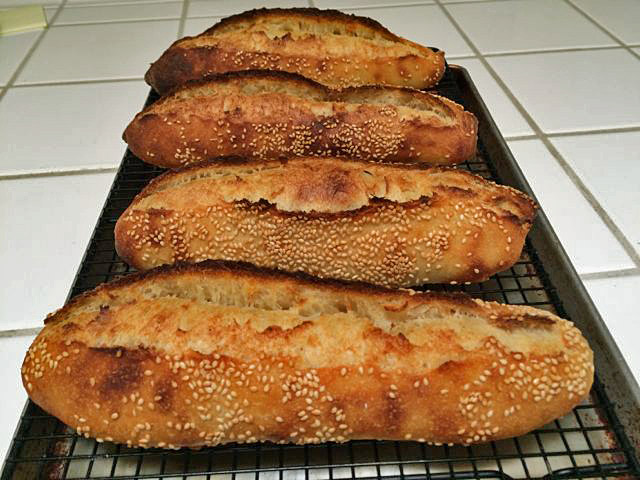
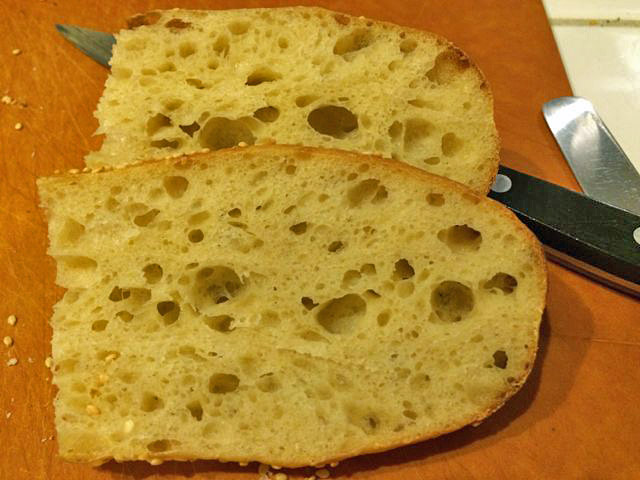
After cooling, the Italian bread crust was soft. The crumb was nicely aerated, but not as open as expected for this level of hydration. I suspect this is because of the durum flour (higher protein but poorer quality gluten) and the extra handling installing the sesame seeds. The flavor is heavenly. This is a sweet white roll with the nuttiness of durum and sesame seeds, dipped in high quality EVOO. How could that not be delicious?
One of the baguettes was consumed for dinner.
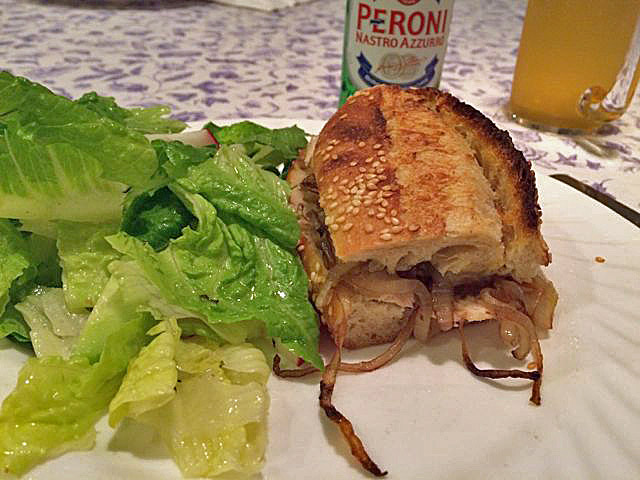
Panino with roast chicken breast, caramelized onions with balsamic vinegar, sliced dried calmyrna figs, emmenthaler cheese and a light smear of Dijon mustard.
Such a sandwich can only be washed down with good Italian beer, of course.
I also baked a couple boules based on the "Overnight Country Blonde" from Ken Forkish's Flour Water Salt Yeast. Summer has arrived, and my kitchen is running 75 to 78 dF, so fermentation runs faster than the book specifies. The result is that bulk fermentation was complete in 5 hours. I refrigerated the dough overnight and divided and shaped the next morning. Even with the dough starting out cold, proofing was complete in about 2 hours.
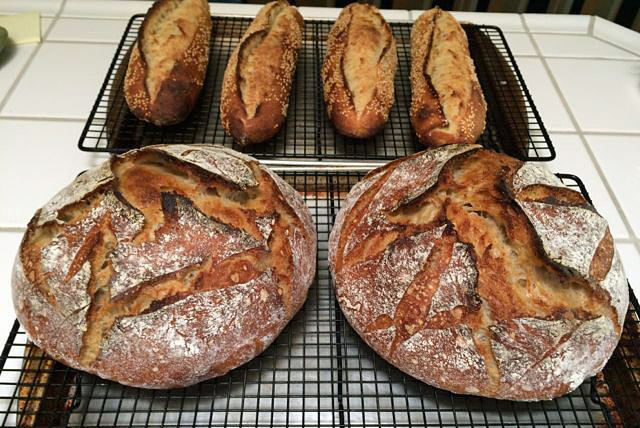
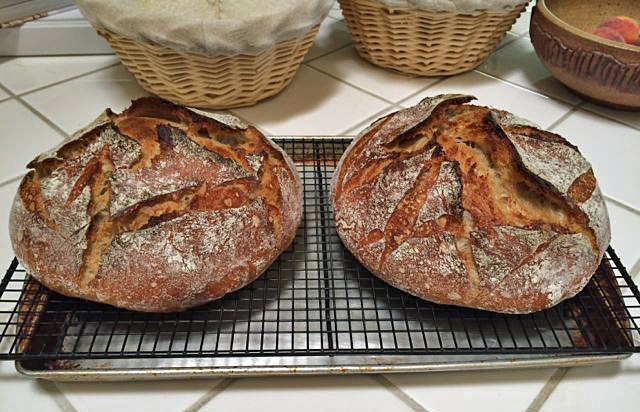
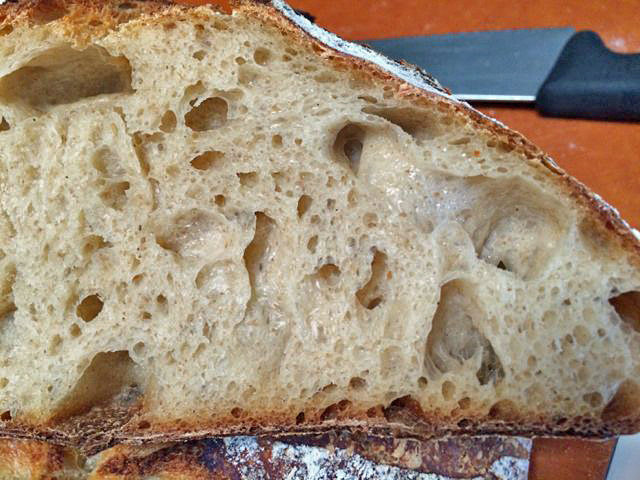
All of the sourdough breads I have made from FWSY have a strong family resemblance but more or less distinctive flavor profiles, depending on the flour mix used, the percentage pre-fermented flour and the fermentation routine. This bread had a crunchy crust and cool, chewy crumb. The flavor had that nice wheaty sweetness and a quite present but mild sourdough tang, with the creamy lactic acid tone dominating. Although this is a higher hydration dough, the flavor profile is very much like the Pain de Campagne from Hamelman's Bread. And that's not bad! Like my San Joaquin Sourdough, it contains mostly AP flour but with about 10% whole grain flours, divided between whole wheat and whole rye. The procedures I used for this bake, with the overnight retardation before dividing and shaping, gave such nice results, I am going to use it for a while and try increasing the whole grain flours, maybe adding some toasted wheat germ for its nutty flavor and who knows what else.
It has been a good bread baking day.
Happy baking!
David
- dmsnyder's Blog
- Log in or register to post comments
Very nice, David. Would you mind if I shared these on the home page for a bit?
Certainly, you may feature them! It's an honor.
David
Hi David,
These demis are just so nice looking. These Italian w/sesame baguettes (and batards) are coming up next on my bread list, just by chance. I think that I'll try these cute guys with the bumped up durum flour percentages and see what gives. I'm starting to warehouse a panoply of my newer creations for a trip up north to give to my in-laws. I'll be proud to lay a few of these on them.
If you make these, please let us know how they work for you ... and your in-laws!
David
Let’s see how many things were off schedule for this bake:
And, and, and – despite all of those miscues (well, the overnight couched retard was planned), the results were really forgiving. I made a 1500g batch to squeeze two 500g batards and two 250g demis into the bake. Still need to get the better oven spring and grigne on these. But the results were satisfying enough considering... And now, going with your 40% durum instead of prior 20%, the taste is just fun-tastic. Really incredible and creamy. Just about as good as I’ve ever had. Close to addictive, and why ruin it with anything other than butter?
See the in-laws at month's end, so there will be a pile of frozen batards packed into my suitcase then.
And now thanks, to you, I’ll be both picking sesame seeds out of my teeth for the next week and hitting the gym 8 hours a day! I think that I’ll do it again this week, follow the real methodology and formula and see what gives (other than my waistline). Just ‘cause...
The demis:
The batards:
Beautiful loaves.
It's a mystery. The SJSD approach appears to have some combination of the characteristics of Superman, the Energizer Bunny and Harry Houdini.
The only nit I would pick with your reply is that I don't think this bread needs butter, even. Maybe toasted with a rub of garlic? When tomatoes are prime, this might be an over the top base for a tomato/garlic/basil bruschetta. Oooooh! Yum!
Have a good trip. Hope you can get the sesame seeds out of your suitcase ... eventually.
David
might have to give them a try. I'l bet they melt in your mouth!
durum color came through in the crumb but alas.....no crumb shot:-( I'm sure they went fast so no worries! Love the boldly baked crust at any rate. Very well done as usual and
Happy baking Daivd
I'll have some more photos uploaded within the next couple hours.
David
and the sweetness had to be delightful. Well done David.
these look awesome! ready to stand up to a italian beef sandwich or meatball sub!
I am confident they would stand up to near any filling. There is just one problem: The flavor of the bread itself is so good, it's a shame to cover it up with strong-flavored sandwich fillings.
The first time I made this bread, I served it with dinner to my sisters, who were visiting. We nearly finished a large loaf. It was hard to stop eating it. We only did so because one sister put a claim on what was left for her breakfast toast.
David
Enjoy!
David
Nice bake as always. Your breads always look great and I enjoy the stories that go along with them. These baguettes look like the perfect sandwich "roll", or just for dipping.
AB
I am pretty sure that the mottling is due to uneven moistening of the crust when I rolled the loaves over damp paper towels, before rolling in sesame seeds.
David
Beautiful breads, David, as usual. I've enjoyed so many of your formulas and here's a new one I'll have to try as I am a sucker for anything with durum flour in it. ;-)
Thank you!!!
Cherie
If you do make these, please let us know how they work for you.
David
Complimenti per il magnifico Pane che hai magistralmente prodotto.
Con te l'impasto non ha segreti........BRAVISSIMO!!!
Sei un grande esempio per tutti noi appassionati e grazie per aver condiviso.
Un abbraccio, Anna
David
I love the addition of the durum and the golden color. Have you retarded as long as 36 hours? That's a really flexible formula. No doubt I will give these a whirl!
-Brad
I retarded SJSD dough for 36 hours once, as an experiment. Another TFL baker had done it and said it worked for him or her. I wanted to see for myself. There wasn't any dramatic difference between a 21 hour and a 36 hour retardation - no clear change in flavor and no indication of increased gluten break down.
The original SJSD which evolved from the Anis Bouabsa baguettes, calls for a 21 hour retardation, because that's what Anis does. What I usually do, which ends up remarkably close to the original, is feed my levain at about 10:30 or 11:00 pm. I mix the autolyse about 12 hours later, after a leisurely breakfast, some internet cruising and other distractions. So, the dough ends up in the fridge at somewhere close to 4:00 or 4:30 pm. I'll take the dough out of the fridge after lunch the next day. Voila! 21 hours' retardation. Fresh baked SJSD for dinner.
You know, one theory about the origins of cold retardation is that it was a procedure for the baker to avoid having to get up and be mixing dough at 2 am for the customers buying baguettes for p'tit déjeuner. There's a lot to be said for that.
David
I love the colour and flavour of semolina and have just put this on tomorrow's to bake list. I am lovinghaving natural starters once again! Happy baking, Ski
I can't imagine anyone not enjoying these, but let us know how they turn out for you.
David
David: I am just ready to take your San Joaquin baguettes out of the oven here in England. Can't wait to try these. Thanks for sharing. Best, Phyllis
Let me know how you and your English family like them.
David
Thanks for sharing this formula. I was just looking for a naturally leavened durum flour recipe - I look forward to giving this a try. One question for you though... I notice that the percentage of whole wheat and rye flour are very low (1-2%). Do you think that they really contribute to the flavor at such low percentages?
The rye and WW flours are entirely from the levain. My standard flour mix for feeding my levain is 70% AP, 20% WW and 10% Whole rye. I doubt if these have much impact on the flavor of this bread. The have an impact on the vigor of my starter.
This bread is very tasty indeed. If you make it, let us know what you think.
David
David - I am curious since you developed this formula what is the reason behind it being called "Italian" - does it have it roots in an Italian formula, or is there something else? Hope that this doesn't sound like some kind of nit-picky accusatory question, because it isn't - just wondered. Thanks.
This bread is not derived directly from an Italian formula. It is derived very indirectly from a French formula, actually. However, with the inclusion of olive oil, durum flour and sesame seeds, it has features associated with Italian breads, at least in my mind.
That's all.
Oh! It has also been much appreciated by the Southern Italian immigrants who have tasted it.
David
I wondered if the olive oil was part of that. All good reasons to be sure. I just might have to give this one a try. Approval and appreciation are always an indicator too.
Hi David,
Your formula worked well for me, thank you! Here's a few pix
Shaping is sometimes where I fall down, but I thought these turned out OK in that department. My scoring should have been deeper, yes? I think I did keep the razor blade at a very shallow angle.....but no ears ;-/ Your scoring looks so awesome - do you go straight down the middle or off to one side? I cut about 2/3 or 3/4 over to one side which was clearly NOT the best way.
Worst problem was: my gas oven lost so much heat while I loaded the loaves. I preheat to 500, Pizza stone and lava rocks in place. Pre-steam with 2 of Sylvia's steaming towel pans. Wait for it to come back to 500 b4 loading loaves (which I managed to time nicely with loaves proofing in the air-conditioned living room). But after I got the loaves in the oven and poured boiling water onto the lava rocks, the oven was down around 370...so no bold bake for me. It took about 15 minutes to bounce back up to 460, but thankfully the loaves still puffed up and bloomed nicely. Any tricks of the trade for more efficient loading? Maybe I will ask that question in a general forum.
Anyway, thanks again for another great formula and happy baking.
cheers,
Cherie
Your loaves look really nice! I'd have one right now! Hmmm ... Maybe I just better go make lunch.
Regarding your exploding dough: Temperature of your kitchen and, maybe, of your fridge is the problem. As the first steps, I would use cooler water for the dough when your kitchen is that warm. A smaller levain inoculation may also help, but by time your refrigerate the dough, it would probably have caught up.
Check your fridge temperature and maybe put the dough at the back of the fridge? I would reserve solutions like a padlock, armed guards, attack dogs, etc. until you have tried the above.
Your oven recovers pretty slowly. Is it gas or electric?
I load this type of bake all at once with a Super Peel. Mine has an "extension" that makes it wider. Last I checked, they don't make the extension any more. Another thought would be to bake under a cover, if you have one big enough. I have used one of those disposable aluminum turkey roasting pans that always appear around Thanksgiving. It worked fairly well.
Regarding scoring: You are making a very common false assumption. It is more likely you need to score less deep. See this, especially item number 7: Scoring Bread made with high-hydration dough
Hope this helps!
David
I'll try your suggestions next time. Hopefully, the dogs will not be necessary, (tho' I'm not sure if anything could keep my guys from snooping around the refrig) I do put the dough in the back. I could turn the temp down to the lowest setting.
My oven is gas and yes, it recovers very slowly...I'll look for a large aluminum roasting pan.
And the scoring tutorial is very informative, much for me to digest and put into practice.
Many thanks!
but unfortunately I over proofed them so no oven spring and they're a little flat, but will still make good garlic bread along side some pizza for dinner.
David: I made this today, and they were fantastic. My husband loved them. The taste is superb, and the crumb was so moist. I finished the semolina flour I had and ran a bit short, so I added 10-15 grams of amaranth flour. I found that the dough was easier to handle the the San Joaquin baguette dough, which I have made so many times. I will definitely make this again and the rolls as well. Thanks for sharing this wonderful recipe. Best, Phyllis
I'm glad you and your husband like the SD Italian bread. I appreciate your letting me know.
David
after only two bakes. Tried it with poppy seeds and I love the extra crunch.
I apologize for what is probably too simple, but I am confused over the use of the "Total Dough" list of measurements, and the "Final Dough" list of measurements. Which should I follow as I attempt this recipe? What is the reason for the two descriptions of the dough. Thank you
To make a sourdough bread according to a formula, you just need the formula for the levain (the sourdough starter that you are going to use) and the formula for the final dough, the ingredients that you mix to make the dough you will be baking.
The total dough accounts for every ingredient that is in the final dough quantitatively. It gives you the true proportions (and amounts) of each component in your bread. This allows you to compare the formula for one bread to that of another in a helpful way. E.g., "Oh. These breads are the same except this one has 20% whole wheat and is 68% hydration and that one has 10% whole wheat and is 72% hydration."
Just to give a simple example: Suppose you are using a liquid levain. This is customarily 100% hydration, meaning the amount of water in it weighs exactly the same as the total amount of flour in it. Now, when you mix your final dough, you might add 500g of flour and 350g of water and 100g of levain. So, what's the resulting hydration of your total dough? Well, you have to add up all the flour in the levain and that which you used in the final dough. You need to do the same for the water. Then you can figure it out.
See, the levain is 100% hydration. The final dough, not counting the levain, would be 350/500 = .7 x 100 = 70% hydration. But that doesn't tell you what the "real" hydration of your bread is. In fact, it is (350+50)/(500+50) = .727x100 = 73%.
It's the same for other ingredients, of example, rye flour. The Total dough tells you what's in the bread. The Levain and Final dough formulas tell you when and how these ingredients are introduced.
Is the difference significant? Make the same dough at 70% and then at 73% hydration, and see what you think.
Anyway, I hope that answered your question and wasn't TMI.
Happy baking!
David
Hi- my first post! Question- have you tried to shape the loaves following room fermentation where bulk increases and the put shaped loaves in refrig for 12-36 hours? If yes, any tips and do the loaves need to come to room temp before baking? Thanks!
Hi, sundog. Welcome to TFL!
This formula is derived from my formula for "San Joaquin Sourdough." One of its prominent characteristics is the cold retardation of the dough before final shaping. Now, I can't see any reason not to try shaping the dough after bulk fermentation and retarding the loaves before baking. I haven't done it. If you do try it, let us know how it works for you.
Bake the loaves when they are at least 3/4 proofed. (I use the "poke test" to judge this.) If they are fully proofed when you take them out of the fridge, bake them. If they need more time at room temperature, give them that.
David